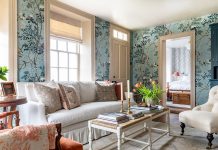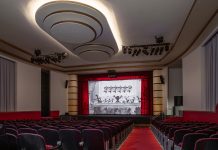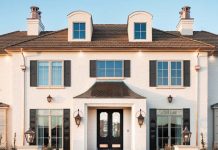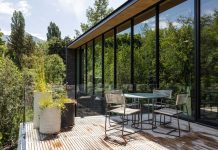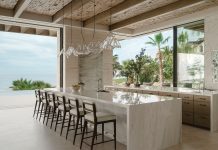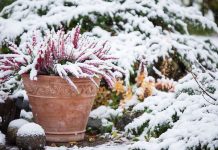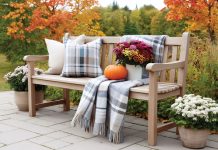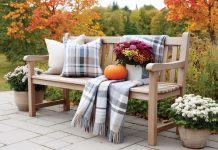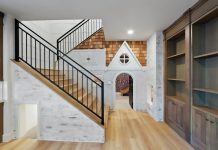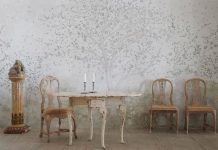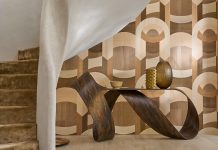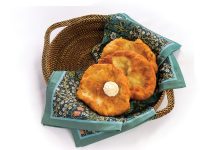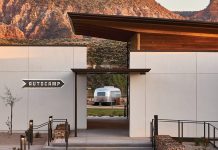In historic Old Town, landscape architect Seth Bockholt transformed idle land into inviting outdoor spaces that expand the style and livability of a Park City home. Photos by Doug Burke.

Park City’s natural beauty and splendid seasons are nothing if not reasons to spend time outdoors. That fact inspired the owners of this Old Town-area house to enlist Seth Bockholt to expand their home’s living quarters beyond its interior walls. “They wanted more elbow room to live and entertain outdoors,” says Bockholt, principal landscape architect and planner with Bockholt Inc.

The team replaced a single window on the side of the house with 12-foot-wide opening. accordion doors fold back to seamlessly open the interior to a wide landing and steps leading to the main patio below.
2. Floor Show
A section of rust-stained concrete flows from the house and across the patio to delineate outdoor spaces. Metal slot drains are cast into this suspended area of the patio to allow storm water to reach the street below.
3. Top Terrace
Located above the main level’s storage shed, the top terrace hosts a raised spa clad in basalt tiles and a metal firewood storage box. A glass-and-wood railing encloses the patio without blocking its mountain views.
4. Custom Furniture
Bockholt designed the patio’s furniture to accommodate the owners’ love of entertaining. He put the pieces on caster so they can be easily moved as well as stored in the shed. The cushions are covered in Sunbrella fabrics.
To make room for more room, Bockholt’s clients acquired the empty lot next door—a rare find in the town’s tight historic district. Administratively combining the properties and then terracing the sloped, untamed lot to make it usable was no small task, Bockholt recalls. “There was a stone wall along the street that had to be dismantled, the stones labeled and warehoused and then replaced and re-stacked in exactly the same way,” he says. Freshly terraced to match the house as it climbs up its canted site, the grass-covered plot became a blank, multi-level canvas upon which Bockholt could work his magic. “It was a fairy-tale project,” Bockholt says. Armed with a fresh space, “dream clients” and a finely-honed vision, Bockholt masterfully transformed the raw site into outdoor living spaces as special as those indoors.
THE LAYOUT
“The natural terracing delineated the spaces,” says Bockholt, who designed them to complement the interior layout of the home. For example, on the upper terrace located off a reading room with a wood-burning fireplace, the designer built an open metal box for firewood storage and a raised spa affording views through wood-framed glass railing. On the 500-square-foot main terrace, an outdoor kitchen, dining area and living space perform like the kindred interior spaces located just steps away through new, 12-foot-wide accordion doors. Ideal for entertaining, the kitchen sits at the front of the patio, the dining area occupies its center and a lounge area—composed of seating circling a fire feature carved from a basalt pillar—is located further back.

THE FLOORS
“This is a simple space, but there is a variety of materials here,” says Bockholt, whose edited palette begins underfoot. Concrete composes the main terrace’s radiant-heated flooring—mainly white-toned concrete sand-blasted with walnut shells to create a non-slip finish. A rust-colored, gridded section appears to roll through the home’s accordion doors like a huge stained-concrete rug as it spills down the steps and crosses the patio to help delineate its living spaces. This earth-toned section not only visually divides the patio, but it was also engineered to “float” above ground to allow drainage through metal slot-drains cast into the concrete. “They allow storm water to go down to the street,” Bockholt explains. On the upper pool deck, the white-colored concrete contrasts with dark basalt tiles that shape and define the raised spa area.

THE WALLS
“Walls are an opportunity for design expression,” says Bockholt, who fashioned distinctive 6-foot-tall “fences” that foster an organic, modern vibe while nodding to Old Town style. He chose board-formed concrete for much of the main privacy wall. “It’s a historic material in Park City,” he says. The designer then gave the feature a twist, capping the wall with an ornamental wood-molding that finishes the cold concrete with contrasting “visual warmth.” Inarguably, most innovative is his 18-foot-long “shadow wall” crafted from the end cuts of 6-inch posts and engineered with a steel support system. The end-cuts vary in length from six to 13 inches, creating a highly dimensional, graphic surface. “The design was inspired by a pixelated topographic map of Park City Resort,” Bockholt explains. The wall also performs visually like a water feature, which the clients vetoed. “Water is important element in design, providing constant movement in a garden, so we thought, ‘How do we make this happen without water?’” he recalls. Ingeniously, he used the play of sunlight across the wall’s high-low surface to create ever-changing shadows and motion.

THE FURNITURE
“There is a lot of badly built, uncomfortable outdoor furniture on the market,” says Bockholt, who designed all of this project’s furniture and crafted it from naturally fallen, Alaskan yellow cedar. The pieces, along with the Sunbrella covered cushions, had to be designed to stack and fit inside the new storage “shed” set behind the patio’s lounge area.

THE PLANTS
“We used plantings to create an organic backdrop that nestles the rectilinear forms,” Bockholt explains. On the main patio, he chose a multi-trunk Rocky Mountain maple that “steals the show” and then planted mounding, seafoam sage and succulents around its base to help soften the wall’s rigidness. A hedgerow of junipers fosters privacy and lush greenery on the upper deck.


